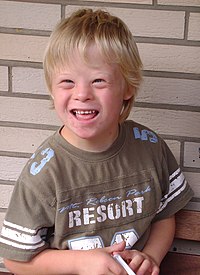
Photo from wikipedia
ObjectiveTo assess the significance of changes in the saliva in the etiology of gingivitis and tooth wear in children and adolescents with Prader-Willi syndrome (PWS).Materials and methodsThe study included 80… Click to show full abstract
ObjectiveTo assess the significance of changes in the saliva in the etiology of gingivitis and tooth wear in children and adolescents with Prader-Willi syndrome (PWS).Materials and methodsThe study included 80 (2.8–18 years old; 39 girls and 41 boys): 40 in PWS group (mean age 8.0 ± 4.24 years) and 40 in control group (mean age 7.9 ± 4.12 years). General condition, oral para-functional habits, tooth wear (modified TWI), oral hygiene and gingival status (Plaque Index (PLI) and Gingival Index (GI)), localization of gingivitis, and salivary characteristics were assessed. The chi-square test, the Mann-Whitney U test, Spearman’s rank correlation, and odds ratio based on logistic regression in a statistical analysis were applied.ResultsChances of gingivitis were increased by low PLI (odds ratio (OR) = 32.53), low resting salivary flow (OR = 3.96), increased viscosity of saliva (OR = 3.54), and mouth breathing (OR = 8.17). For gingivitis in anterior regions, low PLI (OR = 107.67), low resting (OR = 5.73) and stimulated (OR = 1.86) salivary flow, increased viscosity of saliva (OR = 5.87), mouth breathing (OR = 10.00), and low stimulated salivary flow (OR = 3.18) were observed. Tooth wear rates were increased by teeth grinding (OR = 16.20), mouth breathing (OR = 4.33), increased viscosity of saliva (OR = 11.67) and low resting (OR = 6.07), and stimulated (OR = 4.22) salivary flow.ConclusionsIn PWS, reduced salivary secretion, increased viscosity, of saliva and mouth breathing increase the risk of plaque-induced gingivitis and tooth wear.Clinical relevanceThe prevention and treatment of tooth wear and gingivitis in PWS patients is necessary not only to treat bruxism and mouth breathing but also to limit the influence of negative changes of saliva.
Journal Title: Clinical Oral Investigations
Year Published: 2018
Link to full text (if available)
Share on Social Media: Sign Up to like & get
recommendations!